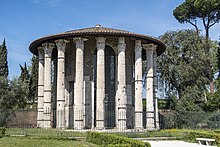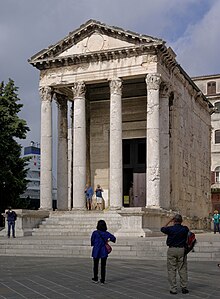 Global Information
Global InformationRoman temple information




Ancient Roman temples were among the most important buildings in Roman culture, and some of the richest buildings in Roman architecture, though only a few survive in any sort of complete state. Today they remain "the most obvious symbol of Roman architecture".[1] Their construction and maintenance was a major part of ancient Roman religion, and all towns of any importance had at least one main temple, as well as smaller shrines. The main room (cella) housed the cult image of the deity to whom the temple was dedicated, and often a table for supplementary offerings or libations and a small altar for incense. Behind the cella was a room, or rooms, used by temple attendants for storage of equipment and offerings. The ordinary worshiper rarely entered the cella, and most public ceremonies were performed outside of the cella where the sacrificial altar was located, on the portico, with a crowd gathered in the temple precinct.[2][3]
The most common architectural plan had a rectangular temple raised on a high podium, with a clear front with a portico at the top of steps, and a triangular pediment above columns. The sides and rear of the building had much less architectural emphasis, and typically no entrances. There were also circular plans, generally with columns all round, and outside Italy there were many compromises with traditional local styles. The Roman form of temple developed initially from Etruscan temples, themselves influenced by the Greeks, with subsequent heavy direct influence from Greece.
Public religious ceremonies of the official Roman religion took place outdoors and not within the temple building. Some ceremonies were processions that started at, visited, or ended with a temple or shrine, where a ritual object might be stored and brought out for use, or where an offering would be deposited. Sacrifices, chiefly of animals, would take place at an open-air altar within the templum; often on one of the narrow extensions of the podium to the side of the steps. Especially under the Empire, exotic foreign cults gained followers in Rome, and were the local religions in large parts of the expanded Empire. These often had very different practices, some preferring underground places of worship, while others, like Early Christians, worshiped in houses.[4]
Some remains of many Roman temples still survive, above all in Rome itself, but the relatively few near-complete examples were nearly all converted into Christian churches (and sometimes subsequently to mosques), usually a considerable time after the initial triumph of Christianity under Constantine. The decline of Roman religion was relatively slow, and the temples themselves were not appropriated by the government until a decree of the Emperor Honorius in 415. Santi Cosma e Damiano, in the Roman Forum, originally the Temple of Romulus, was not dedicated as a church until 527. The best known is the Pantheon, Rome, which, however, is highly untypical, being a very large circular temple with a magnificent concrete roof, behind a conventional portico front.[5]
- ^ Summerson (1980), 25
- ^ Sarah Iles Johnston (2004). Religions of the Ancient World: A Guide. Harvard University Press. p. 278. ISBN 0674015177.
- ^ Hans-Josef Klauck (2003). Religious Context of Early Christianity: A Guide To Graeco-Roman Religions (reprint ed.). A&C Black. p. 23. ISBN 0567089436.
- ^ Sear
- ^ Wheeler, 104–106; Sear